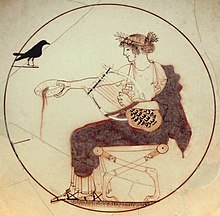Timeline of zoology
hideThis article has multiple issues. Please help or discuss these issues on the talk page. (Learn how and when to remove these template messages)
|
A timeline of the history of zoology.
Ancient world[]
- 28000 BC. Cave painting (e.g. Chauvet Cave) in but, especially Spain, depict animals in a stylized fashion. Mammoths (the same species later to be seen thawing from ice in Siberia) were depicted in these European cave paintings.
- 10000 BC. Man (Homo sapiens) domesticated dogs, pigs, sheep, goats, fowl, and other animals in Europe, northern Africa and the Near East.[1]
- 6500 BC. The aurochs, ancestor of domestic cattle, would be domesticated in the next two centuries if not earlier (Obre I, Yugoslavia). This was the last major food animal to be tamed for use as a source of milk, meat, power, and leather in the Old World.
- 3500 BC. Sumerian animal-drawn wheeled vehicles and plows are developed in Mesopotamia, the region called the "Fertile Crescent" by U.S. archaeologist James Henry Breasted (1865–1935). Irrigation may also have used animal power. By increasing the area under cultivation and reducing the number of people required to raise food, society will permit a few people to become priests, artisans, scholars, and merchants. Since Sumeria had no natural defenses, armies with mounted cavalry and chariots became important, with this and other developments increasing the importance of equines (horses and asses).
- 2000 BC. Domestication of the silkworm in China.
- 1100 BC. Won Chang (China), first of the Chou emperors, stocked his imperial zoological garden with deer, goats, birds and fish from many parts of the world. The emperor also enjoyed sporting events with the use of animals.
- 850 BC. Homer (Greek), reputedly a blind poet, wrote the epics Iliad and Odyssey. Both contain animals as monsters and metaphors (gross soldiers turned into pigs by the witch Circe), but also some correct observations on bees and fly maggots. Both epics make reference to mules.
- 610 BC. Anaximander (Greek, 610 BC–545 BC) was a student of Thales of Miletus. The first life, he taught, was formed by spontaneous generation in the mud. Later animals came into being by transmutations, left the water, and reached dry land. Man was derived from lower animals, probably aquatic. His writings, especially his poem On Nature, were read and cited by Aristotle and other later philosophers, but are lost.
- 563? BC. Buddha (Indian, 563?–483 BC) had gentle ideas on the treatment of animals. Animals are held to have intrinsic worth, not just the values they derive from their usefulness to man.
- 500 BC. Empedocles of Agrigentum (Greek, 504–433 BC) reportedly rid a town of malaria by draining nearby swamps. He proposed the theory of the four humors and a natural origin of living things.

- 500 BC. Alcmaeon (Greek, c. 500 BC) performed human dissections. He identified the optic nerve, distinguished between veins and arteries, and showed that the nose was not connected to the brain. He made much of the tongue and explained how it functioned. He also gave an explanation for semen and for sleep.
- 500 BC. Xenophanes (Greek, 576–460 BC), a disciple of Pythagoras (?–497 BC), first recognized fossils as animal remains and inferred that their presence on mountains indicated the latter had once been beneath the sea. "If horses or oxen had hands and could draw or make statues, horses would represent the forms of gods as horses, oxen as oxen." Galen (130?–201?) revived interest in fossils that had been rejected by Aristotle, and the speculations of Xenophanes were again viewed with favor.
- 470 BC. Democritus of Abdera (Greek, 470–370 BC) made dissections of many animals and humans. He was the first Greek philosopher-scientist to propose a classification of animals, dividing them into blooded animals (Vertebrata) and bloodless animals (Evertebrata). He also held that lower animals had perfected organs and that the brain was the seat of thought.
- 460 BC. Hippocrates (Greek, 460?–377? BC), the "Father of Medicine", used animal dissections to advance human anatomy. Fifty books attributed to him were assembled in Alexandria in the 3rd century BC. These probably represent the works of several authors, but the treatments given are usually conservative.
- 440 BC. Herodotus of Halikarnassos (Greek, 484–425 BC) treated exotic fauna in his Historia, but his accounts are often based on tall tales. He explored the Nile, but much of ancient Egyptian civilization was already lost to living memory by his time.
- 384 BC. Aristotle (Greek, 384–322 BC) studied under Plato, but he was not reluctant to disagree with the master. His books Historia Animalium (9 books), De Partibus Animalium, and De Generatione Animalium set the zoological stage for centuries. He emphasized the value of direst observation, recognized law and order in biological phenomena, and derived conclusions inductively from observed facts. He believed that there was a natural scale that ran from simple to complex. He made advances in the area of marine biology, basing his writings on keen observation and rational interpretation as well as conversations with local Lesbos fishermen for two years, beginning in 344 BC. His account of male protection of eggs by the barking catfish was scorned for centuries until Louis Agassiz confirmed Aristotle's description. Aristotle's botanical works are lost, but those of his botanical student Theophrastos of Eresos (372–288 BC) are still available (Inquiry into Plants).
- 340 BC. Plato (Greek, 427–347 BC) held that animals existed to serve man, but they should not be mistreated because this would lead people to mistreat other people. Others who have echoed this opinion are St. Thomas Aquinas, Immanuel Kant, and Albert Schweitzer.
- 323 BC. Alexander the Great (Macedonian, 356–323 BC) collected animals, some perhaps for his old teacher Aristotle, when he was not busy conquering the known world. He is credited with the introduction of the peacock into Europe. Aside from its decorative tail feathers, the peacock (a pheasant) was eaten regularly by Europeans until the arrival of the turkey.
- 95 BC. Lucretius (Titus Lucretius Carus) (Roman, 96?–55 BC) spent his whole life writing one poem (still unfinished), called De Rerum Natura, with a version of the atomic theory, a theory of heredity, etc.
- 70 BC. Publius Vergilius Maro (Virgil) (70–19 BC) was a famous Roman poet. His poems Bucolics (42–37 BC) and Georgics (37–30 BC) hold much information on animal husbandry and farm life. His Aeneid (published posthumously) has many references to the zoology of his time.
- 36 BC. Marcus Terentius Varro (116–27 BC) wrote De Re Rustica, a treatise that includes apiculture. He also treated the problem of sterility in the mule and recorded a rare instance in which a fertile mule was bred.
- 50. Lucius Annaeus Seneca (Roman, 4 BC–AD 65), tutor to Roman emperor Nero, maintained that animals have no reason, just instinct, a "stoic" position. He remarked on the ability of glass globes filled with water to magnify small objects.
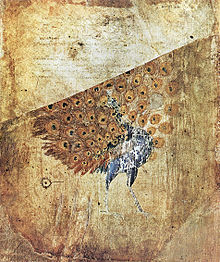
- 77. Pliny the Elder (Roman, 23–79) wrote his Historia Naturalis in 37 volumes. This work is a catch-all of zoological folklore, superstitions, and some good observations.
- 79. Pliny the Younger (Roman, 62–113), nephew of Pliny the Elder, inherited his uncle's notes and wrote on beekeeping.
- 100. Plutarch (Roman, 46?–120) stated that animals' behavior is motivated by reason and understanding. Life of the ant mirrors the virtues of friendship, sociability, endurance, courage, moderation, prudence, and justice.
- 131. Galen of Pergamum (Greek, 131?–201?), physician to Roman Emperor Marcus Aurelius, wrote on human anatomy from dissections of animals. His texts were used for hundreds of years, gaining the reputation of infallibility.
- 200 c. Various compilers in post-classical and medieval times added to the Physiologus (or, more popularly, the Bestiary), the major book on animals for hundreds of years. Animals were believed to exist in order to serve man, if not as food or slaves then as moral examples.
Middle Ages[]

Isidoro di siviglia, etimologie,. Bruxelles, Bibliothèque Royale Albert I
- 600 c. Isidorus Hispalensis (Spanish bishop of Seville) (560–636) wrote Origines sive Etymologiae, a compendium on animals that served until the rediscovery of Aristotle and Pliny. Full of errors, it nevertheless was influential for hundreds of years. He also wrote De Natura Rerum.
- 781. Al-Jahiz (Afro-Arab, 781–868/869), a scholar at Basra, wrote on the influence of environment on animals.
- 901. Horses came into wider use in those parts of Europe where the three-field system produces grain surpluses for feed, but hay-fed oxen were more economical, if less efficient, in terms of time and labor and remained almost the sole source of animal power in southern Europe, where most farmers continued to use the two-field system.

Ploughing with oxen in the 15th century. Très Riches Heures du Duc de Berry
- 1114. Gerard of Cremona (1114–1187), after the capture of Toledo and its libraries from the Moors, translated Ptolemy, Aristotle, Euclid, Hippocrates, Galen, Pliny and many other classical authors from the Arabic.
- 1244–1248. Frederick II von Hohenstaufen (Holy Roman Emperor) (1194–1250) wrote De Arte Venandi cum Avibus (The Art of Hunting with Birds) as a practical guide to ornithology. Hawking was the sport for royalty in those days.
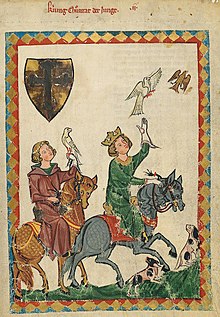
- 1244. Vincentius Bellovacensis (Vincent of Beauvais) (?–1264) wrote Speculum Quadruplex Naturale, Doctrinale, Morale, Historiale (1244–1254), a major encyclopedia of the 13th century. This work comprises three huge volumes, of 80 books and 9,885 chapters.
- 1248. Thomas of Cantimpré‚ (Fleming, 1204?–1275?) wrote Liber de Natura Rerum, a major 13th-century encyclopedia.
- 1254–1323. Marco Polo (Italian, 1254–1323) provided information on Asiatic fauna, revealing new animals to Europeans. "Unicorns" (rhinos?) were reported from southern China, but fantastic animals were otherwise not included.
- 1255–1270. Albertus Magnus of Cologne (Bavarian, 1206?–1280) (Albert von Bollstaedt or St. Albert) wrote De Animalibus. He promoted Aristotle but also included new material on the perfection and intelligence of animals, especially bees.
- 1304–1309. Petrus de Crescentii wrote Ruralum Commodorum, a practical manual for agriculture with many accurate observations on insects and other animals. Apiculture was discussed at length.
- 1453. The fall of Constantinople to the Turks ended the Byzantine Empire. Greek manuscripts became known in Europe, including books by Aristotle and Theophrastos that were translated into Latin by Theodore Gaza (Greek, ?–1478).

- 1492–1555. Edward Wotton (English, 1492–1555) wrote De Differentiis Animalium, a well thought-out work that influenced Gesner.
- 1492. Christopher Columbus (Italian) arrives in the New World. New animals soon begin to overload European zoology. Columbus is said to have introduced cattle, horses, and eight pigs from the Canary Islands to Hispaniola in 1493, giving rise to virtual devastation of that and other islands. Pigs were often set ashore by sailors to provide food on the ship's later return. Feral populations of hogs were often dangerous to humans.
- 1500 c. Paracelsus (Theophrastus Bambastus von Hohenheim) (Swiss or German?, 1493–1541), alchemist, wrote that poisons should be used against disease: he recommended mercury for treating syphilis.
- 1519–1520. Bernal Diaz del Castillo (Spanish, 1450?–1500), chronicler of Cortez's conquest of Mexico, commented on the zoological gardens of Aztec ruler Montezuma (1466–1520), a marvel with parrots, rattlesnakes, etc.
- 1523. Gonzalo Fernández de Oviedo y Valdés(Spanish, 1478–1557), appointed official historiographer of the Indies in 1523, wrote Sumario de la Natural Historia delas Indias (Toledo, 1527). He was the first to describe many New World animals, such as the tapir, opossum, manatee, iguana, armadillo, ant-eaters, sloth, pelican, humming birds, etc.
Modern world[]
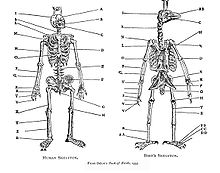
A comparison of the skeleton of birds and man in Belon's book on birds, 1555
- 1551–1555. Pierre Belon (French, 1517–1564) wrote L'Histoire Naturelle des Estranges Poissons Marins (1551) and La Nature et Diversité des Poissons (1555). This latter work included 110 animal species and offered many new observations and corrections to Herodotus. L'Histoire de la nature des oyseaux avec leurs descriptions et naïfs portraicts (1555) was his picture book, with improved animal classification and accurate anatomical drawings. In this he published a man's and a bird's skeleton side by side to show the resemblance. He discovered an armadillo shell in a market in Syria, showing how Islam was distributing the finds from the New World.
- 1551. Conrad Gessner (Swiss, 1516–1565) wrote Historia animalium (Tiguri, 4 vols., 1551–1558, last volume published in 1587) and gained renown. This work, although uncritically compiled in places, was consulted for over 200 years. He also wrote Icones animalum (1553) and Thierbuch (1563).
- 1554–1555. Guillaume Rondelet (French, 1507–1566) wrote Libri de piscibus marinis (1554) and Universe aquatilium historia (1555). He gathered vernacular names in hope of being able to identify the animal in question. He did go to print with discoveries that disagreed with Aristotle.
- 1574. Johannes Faber (1576–1629), an early entomologist and member of the Accademia dei Lincei in Rome, gave the microscope its name.
- 1578. Jean de Lery (French, 1534–1611) was a member of the French colony at Rio de Janeiro. He published Voyage en Amerique avec la description des animaux et plantes de ce pays (1578) with observations on the local fauna.
- 1585. Thomas Harriot (English, 1560–1621) was a naturalist with the first attempted English colony in North America, on Roanoke Island, North Carolina. His Brief and True Report of the New Found Land of Virginia (1590) describes the black bear, gray squirrel, hare, otter, opossum, raccoon, skunk, Virginia and mule deer, turkeys, horseshoe crab (Limulus), etc.
- 1589. José de Acosta (Spanish, 1539–1600) wrote De Natura Novi Orbis Libri duo (1589) and Historia Natural y Moral de las Indias (1590), describing many previously unknown animals from the New World.
17th century[]
- 1600. In Italy a spider scare lead to hysteria and the tarantella dance by which the body cures itself through physical exertions.
- 1602. Ulisse Aldrovandi (Italian, 1522–1605) wrote De Animalibus Insectis. This and his other works include much nonsense, but he used wing and leg morphology to construct his classification of insects. He is more highly regarded for his ornithological contributions.
- 1604–1614. Francisco Hernández de Toledo (Spanish) was sent to study Mexican biota in 1593–1600, by Philip II of Spain. His notes were published in Mexico in 1604 and 1614, describing many animals for the first time: coyote, buffalo, axolotl, porcupine, pronghorn antelope, horned lizard, bison, peccary and the toucan. He also figured many animals for the first time: ocelot, rattlesnake, manatee, alligator, armadillo, and the pelican.
- 1607 (1612?). Captain John Smith (English), head of the Jamestown colony, wrote A Map of Virginia in which he describes the physical features of the country, its climate, plants and animals, and inhabitants. He describes the raccoon, muskrat, flying squirrel, as well as a score of animals, all well identifiable. (In 1609 the Jamestown, Virginia, colony was almost lost when settlers found that their stores had been devoured by rats from English ships.)
- 1617. Garcilaso de la Vega (Peruvian Spanish, 1539–1617) wrote Royal Commentaries of Peru, containing descriptions of the condor, ocelots, puma, viscacha, tapir, rhea, skunk, llama, huanaco, paca, and vicuña.
- 1620? North American colonists probably introduced the European honeybee, Apis mellifera, into Virginia. By the 1640s these insects were also in Massachusetts. They became feral and advanced through eastern North America before the settlers.
- 1628. William Harvey (English, 1578–1657) published Exercitatio Anatomica de Motu Cordis et Sanguinis in Animalibus (1628) with the doctrine of the circulation of blood (an inference made by him in about 1616).
- 1634. William Wood (English) wrote New England Prospect (1634) in which he describes New England's fauna.
- 1637. Thomas Morton (English, c. 1579–1647) wrote New English Canaan (1637) with treatments of 26 species of mammals, 32 birds, 20 fishes and 8 marine invertebrates.
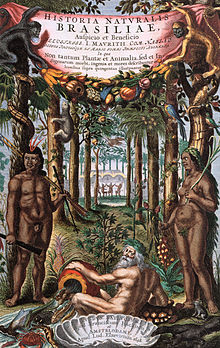
Title plate of Historia Naturalis Brasiliae
- 1648. Georg Marcgrave (?–1644) was a German astronomer working for Johann Moritz, Count Maurice of Nassau, in the Dutch colony set up in northeastern Brazil. His Historia Naturalis Brasiliae (1648) contains the best early descriptions of many Brazilian animals. Marcgrave used Tupi names that were later Latinized by Linnaeus in the 13th edition of the Systema Naturae. The biological and linguistic data could have come from Moraes, a Brazilian Jesuit priest turned apostate.
- 1651. William Harvey published Exercitationes de Generatione Animalium (1651) with the aphorism Ex ovo omnia on the title page.
- 1661. Marcello Malpighi (Italian, 1628–1694) discovered capillaries (1661), structures predicted to exist by Harvey some thirty years earlier. Malpighi was the founder of microanatomy. He studied, among other things, the anatomy of the silkworm (1669) and the development of the chick (1672).
- 1662. John Graunt (English) provided the beginnings of demography with his Natural and Political Observations ... made upon the Bills of Mortality (1662). His speculations on Adam's and Eve's descendants and their growth rates showed an understanding of geometrical population increase. He found that more males than females were born, a fact considered by Sir Matthew Hale as providential for the "needs of warfare".
- 1665. Robert Hooke (English, 1635–1703) wrote Micrographia (1665, 88 plates), with his early microscopic studies. He coined the term "cell".
- 1668. Francesco Redi (Italian, 1621–1697) wrote Esperienze Intorno alla Generazione degli Insetti (1668) and De animaculis vivis quae in corpribus animalium vivorum reperiuntur (1708). His refutation of spontaneous generation in flies is still considered a model in experimentation.
- 1669. Jan Swammerdam (Dutch, 1637–1680) wrote Historia Insectorum Generalis (1669) describing metamorphosis in insects and supporting the performation doctrine. He was a pioneer in microscopic studies. He gave the first description of red blood corpuscles and discovered the valves of lymph vessels. His work was unknown and unacknowledged until after his death.
- 1672. Regnier de Graaf (1641–1673) reported that he had traced the human egg from the ovary down the fallopian tube to the uterus. What he really saw was the follicle.
- 1675–1722. Antonie van Leeuwenhoek (Dutch, 1632–1723) wrote Arcana Naturae Detectae Ope Microscopiorum Delphis Batavorum, a treatise with early observations made with microscopes. He discovered blood corpuscles, striated muscles, human spermatozoa (1677), protozoa (1674), bacteria (1683), rotifers, etc.
- 1691. John Ray (English, 1627–1705) wrote Synopsis methodica animalium quadripedum (1693), Historia Insectorum (1710), and The Wisdom of God Manifested in the Works of the Creation (1691). He tried to classify different animal species into groups largely according to their toes and teeth.
- 1699. Edward Tyson (English, 1650–1708) wrote Orang-Outang sive Homo Sylvestris (or Anatomy of a Pygmie Compared with that of a Monkey, an Ape and a Man) (1699), his anatomical study of the primate. This was the first detailed and accurate study of the higher apes. Other studies by Tyson include the female porpoise, male rattlesnake, tapeworm, roundworm (Ascaris), peccary and opossum.
18th century[]
- 1700? Discovery of the platypus in Australia.
- 1700. Félix de Azara (Spanish) estimated the feral herds of cattle on the South American pampas at 48 million animals. These animals probably descended from herds introduced by the Jesuits some 100 years earlier. (North America and Australia were to follow in this pattern, where feral herds of cattle and mustangs would explode, become pests, and reform the frontier areas.)

Ants, spiders and hummingbird. Plate from Metamorphosis insectorum surinamensis
- 1705. Maria Sybilla Merian (German, 1647–1717) wrote and beautifully illustrated her Metamorphosis insectorum surinamensis (Veranderingen der Surinaamsche Insecten) (1705). In this book she stated that Fulgora lanternaria was luminous.
- 1730? Sir Hans Sloane (English (born Ireland), 1660–1753) was a founder of the British Museum.
- 1734–1742. René Antoine Ferchault de Réaumur (French, 1683–1756) was an early entomologist. His Mémoires pour servir ... l'histoire des insectes (6 volumes) shows the best of zoological observation at the time. He invented the glass-fronted bee hive.
- 1740. Abraham Trembley, Swiss naturalist, discovered the hydra which he considered to combine both animal and plant characteristics. His Mémoires pour Servir ... l'Histoire d'un Genre de Polypes d'Eau Douce ... Bras en Terme de Cornes (1744) showed that freshwater polyps of Hydra could be sectioned or mutilated and still reform. Regeneration soon became a topic of inquiry among Réaumur, Bonnet, Spallanzani, and others.
- 1745. Charles Bonnet (French-Swiss, 1720–1793) wrote Traité d'Insectologie (1745) and Contemplation de la nature (1732). He confirmed parthenogenesis of aphids.
- 1745. Pierre Louis M. de Maupertuis (French, 1698–1759) went to Lapland to measure the arc of the meridian (1736–1737). Maupertuis was a Newtonian. He generated family trees for inheritable characteristics (e.g., haemophilia in European royal families) and showed inheritance through both the male and female lines. He was an early evolutionist and head of the Berlin Academy of Sciences. In 1744 he proposed the theory that molecules from all parts of the body were gathered into the gonads (later called "pangenesis"). Vénus physique was published anonymously in 1745. Maupertuis wrote Essai de cosmologie in which he suggests a survival of the fittest concept: "Could not one say that since, in the accidental combination of Nature's productions, only those could survive which found themselves provided with certain appropriate relationships, it is no wonder that these relationships are present in all the species that actually exist? These species which we see today are only the smallest part of those which a blind destiny produced."
- 1748. John Tuberville Needham, an English naturalist, wrote Observations upon the Generation, Composition, and Decomposition of Animal and Vegetable Substances in which he offers "proof" of spontaneous generation. Needham found flasks of broth teeming with "little animals" after having boiled them and sealed them, but his experimental techniques were faulty.
- 1748–1751. Peter Kalm (Swede) was a naturalist and student of Linnaeus. He traveled in North America (1748–1751).
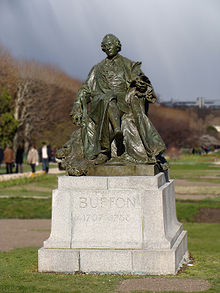
Statue of Buffon in the Jardin des Plantes in Paris.
- 1749–1804. Georges-Louis Leclerc, Comte de Buffon (French, 1707–1788) wrote Histoire Naturelle (1749–1804 in 44 vols.) that had a great impact on zoology. He asserted that species were mutable. Buffon also drew attention to vestigial organs. He held that spermatozoa were "living organic molecules" that multiplied in the semen.
- 1758. Albrecht von Haller (Swiss, 1708–1777) was one of the founders of modern physiology. His work on the nervous system was revolutionary. He championed animal physiology, along with human physiology. See his textbook Elementa Physiologiae Corporis Humani (1758).
- 1758. Carl Linnaeus (Swedish, 1707–1778) published the Systema Naturae whose tenth edition (1758) is the starting point of binomial nomenclature for zoology.
- 1759. Caspar Friedrich Wolff (1733–1794) wrote Theoria Generationis (1759) that disagreed with the idea of preformation. He supported the doctrine of epigenesis. A youthful follower of the German philosopher Gottfried Wilhelm von Leibniz (1646–1716), Wolff sought to resolve the problem of hybrids (mule, hinny, apemen) in his epigenesis, since these could not be well explained by performation.
- 1768. Sir Joseph Banks (1743–1820) and Daniel Solander (1733–1782) sailed with Captain James Cook (English, 1728–1779) on the H.M.S. Endeavour for the South Seas (Tahiti), until 1771.
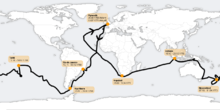
Route of the First voyage of James Cook
- 1769. Edward Bancroft (English) wrote An Essay on the Natural History of Guyana in South America (1769) and advanced the theory that flies transmit disease.
- 1771. Johann Reinhold Forster (German, 1729–1798) was the naturalist on Cook's second voyage around the world (1772–1775). He published a Catalogue of the Animals of North America (1771) as an addendum to Kalm's Travels. He also studied the birds of Hudson Bay.
- 1774. Gilbert White (English) wrote The natural history and antiquities of Selborne, in the county of Southampton (1774) with fine ornithological observations on migration, territoriality and flocking.
- 1775. Johan Christian Fabricius (Danish, 1745–1808) wrote Systema Entomologiae (1775), Genera Insectorum (1776), Philosophia Entomologica (1778), Entomologia Systematica (1792–1794, in six vols.), and later publications (to 1805), to make Fabricius one of the world's greatest entomologists.
- 1776. René Dutrochet (French, 1776–1832) proposed an early version of the cell theory.
- 1780. Lazaro Spallanzani (Italian, 1729–1799) performed artificial fertilization in the frog, silkmoth and dog. He concluded from filtration experiments that spermatozoa were necessary for fertilization. In 1783 he showed that human digestion was a chemical process since gastric juices in and outside the body liquefied food (meat). He used himself as the experimental animal. His work to disprove spontaneous generation in microbes was resisted by John Needham (English priest, 1713–1781).
- 1780. Antoine Lavoisier (French, 1743–1794) and Pierre Laplace (French, 1749–1827) wrote Memoir on heat. Animal respiration was a form of combustion, a conclusion reached by this discoverer of Oxygen.

Eulemur mongoz, plate from Johann Schreber's Histoire naturelle des quadrupèdes représentés d´après nature
- 1783–1792. Alexandre Rodrigues Ferreira (Brazilian) undertook biological exploration. He wrote Viagem Filosófica pelas Captanias do Grão-Pará, Rio Negro, Mato Grosso e Cuiabá. His specimens were taken by Saint-Hilaire from Lisbon to the Paris Museum during the Napoleonic invasion of Portugal. He is considered the "Brazilian Humboldt".
- 1784. Johann Wolfgang von Goethe (German) wrote Erster Entwurf einer Einleitung in die vergleichende Anatomie (1795) that promoted the idea of archetypes to which animals should be compared. Vitalist and romantic, his zoology mostly follows Lorenz Oken.
- 1784. Thomas Jefferson (American) wrote Notes on the State of Virginia (1784) that refuted some of Buffon's mistakes about New World fauna. As U.S. President, he dispatched the Lewis and Clark expedition to the American West (1804).
- 1789? Guillaume Antoine Olivier (French, 1756–1814) wrote Entomologie, or Histoire Naturelle des Insectes (1789).
- 1789. George Shaw & Frederick Polydore Nodder published The Naturalist's Miscellany: or coloured figures of natural objects drawn and described immediately from nature (1789–1813) in 24 volumes with hundreds of color plates.
- 1792. François Huber made original observations on honeybees. In his Nouvelles Observations sur les Abeilles (1792) he noted that the first eggs laid by queen bees develop into drones if her nuptial flight had been delayed and that her last eggs would also give rise to drones. He also noted that rare worker eggs develop into drones. This anticipated by over 50 years the discovery by Jan Dzierżon that drones come from unfertilized eggs and queen and worker bees come from fertilized eggs.
- 1793. Lazaro Spallanzani (Italian, 1729–1799) conducted experiments on the orientation of bats and owls in the dark.
- 1793. Christian Konrad Sprengel (1750–1816) wrote Das entdeckte Geheimniss der Natur im Bau und in der Befruchtung der Blumen (1793) that was a major work on insect pollination of flowers, previously discovered in 1721 by Philip Miller (1694–1771), the head gardener at Chelsea and author of the famous (1731–1804).

Plaque commemorating Christian Konrad Sprengel
- 1794. Erasmus Darwin (English, grandfather of Charles Darwin) wrote Zoönomia, or the Laws of Organic Life (1794) in which he advanced the idea that environmental influences could transform species.
- 1795. James Hutton (English) wrote Theory of the Earth (1795) in which he interpreted certain geological strata as former sea beds.
- 1796–1829. Pierre André Latreille (French, 1762–1833) sought to provide a "natural" system for the classification of animals, in his many monographs on invertebrates. Insectes de l'Amerique Equinoxiale (1811) was devoted to insects collected by Humboldt and Bonpland.
- 1798. Thomas Robert Malthus (English, 1766–1834) wrote Essay on the Principle of Population (1798), a book that was important to both Darwin and Wallace.
- 1799. George Shaw (English) provided the first description of the duck-billed platypus.[3] Everard Home (1802) provided the first complete description.
- 1799–1803. Alexander von Humboldt (German, 1769–1859) and Aimé Jacques Alexandre Goujaud Bonpland (French) arrived in Venezuela in 1799. Humboldt's Personal Narrative of Travels to the Equinoctial Regions of America during the years 1799–1803 and Kosmos were very influential in his time and since.
- 1799. Georges Cuvier (French, 1769–1832) established comparative anatomy as a field of study. He also founded the science of paleontology. He wrote Leçons d'Anatomie Comparée (1801–1805), Le Règne Animal distribué d'après son organisation (1816), Ossemens Fossiles (1812–1813). He believed in the fixity of species and the Biblical Flood. His early Tableau élémentaire de l'histoire naturelle des animaux (1798) was influential, but it did not include Cuvier's major contributions to animal classification.
- 1799. American hunters killed the last bison in the American East, in Pennsylvania.
19th century[]
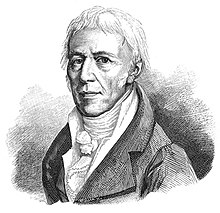
Portrait of Jean-Baptiste Lamarck
- 1802. Jean-Baptiste de Lamarck (French, 1744–1829) wrote Recherches sur l'Organisation des Corps Vivants and Philosophie zoologique (1809). He was an early evolutionist and organized invertebrate paleontology. While Lamarck's contributions to science include work in meteorology, botany, chemistry, geology, and paleontology, he is best known for his work in invertebrate zoology and his theoretical work on evolution. He published an impressive seven-volume work, Histoire naturelle des animaux sans vertèbres ("Natural history of animals without backbones"; 1815–1822).
- 1813–1818. William Charles Wells (Scottish-American, 1757–1817) was the first to recognise the principle of natural selection. He read a paper to the Royal Society in 1813 (but not published until 1818) which used the idea to explain differences between human races. The application was limited to the question of how different skin colours arose.
- 1815. William Kirby and William Spence (English) wrote An Introduction to Entomology (first edition in 1815). This was the first modern entomology text.
- 1817. Georges Cuvier wrote Le Règne Animal (Paris).
- 1817–1820. Johann Baptist von Spix (German, 1781–1826) and Carl Friedrich Philipp von Martius (German) conducted Brazilian zoological and botanical explorations (1817–1820). See their Reise in Brasilien auf Befehl Sr. Majestät Maximilian Joseph I König von Bayern in den Jahren 1817 bis 1820 gemacht und beschrieben (3 vols., 1823–1831).
- 1817. William Smith, in his Strategraphical System of Organized Fossils (1817) showed that certain strata have characteristic series of fossils.

1825 plate from Fauna Japonica Philipp Franz von Siebold
- 1817. Thomas Say (American, 1787–1834) was a brilliant young systematic zoologist until he moved to the utopian community at New Harmony, Indiana, in 1825. Luckily, most of his insect collections have been recovered.
- William Lawrence (English, 1783–1867) published a book of his lectures to the Royal College of Surgeons in 1819. The book contains a remarkably clear rejection of Lamarckism (soft inheritance), proto-evolutionary ideas about the origin of mankind, and a forthright denial of the 'Jewish scriptures' (= Old Testament). He was forced to suppress the book after the Lord Chancellor refused copyright and other powerful men made threatening remarks. His subsequent life was highly successful.
- 1824. The Royal Society for the Prevention of Cruelty to Animals (RSPCA) is founded at London.
- 1825. Gideon Mantell (English) wrote "Notice on the Iguanodon, a newly discovered fossil reptile, from the sandstone of Tilgate Forest, in Sussex" (Phil. Trans. Roy, Soc. Lond., 115: 179–186), the first paper on dinosaurs. The name dinosaur was coined by anatomist Richard Owen.
- 1826. The Zoological Gardens in Regent's Park is founded by the Zoological Society of London with help from Sir Thomas Raffles. It opened its "zoo" to the public for two days a week beginning April 27, 1828, with the first hippopotamus to be seen in Europe since the ancient Romans showed one at the Coliseum. The Society will help save bird and animal species from extinction.
- 1826–1839. John James Audubon (Haitian-born American, 1785–1851) wrote Birds of America (1826–1839), with North American bird portraits and studies. See also his posthumously published volume on North American. Quadrupeds, written with his sons and the naturalist John Bachman, The Viviparous Quadrupeds of North America (1845–1854) with 150 folio plates.
- 1827. Karl Ernst von Baer (Russian embryologist, 1792–1876) was the founder of comparative embryology. He demonstrated the existence of the mammalian ovum, and he proposed the germ-layer theory. His major works include De ovi mammalium et hominis genesi (1827) and Über Entwickelungsgeschichte der Tiere (1828; 1837).
- 1829. James Smithson (English, 1765–1829) donated seed money in his will for the founding of the Smithsonian Institution in Washington.
- 1830–1833. Sir Charles Lyell (English, 1797–1875) wrote Principles of Geology and gave the time needed for evolution to work. Darwin took this book to sea on the Beagle. Past environments were probably much more perturbed than Lyell admitted.
- 1830. Étienne Geoffroy Saint-Hilaire (French, 1772–1844) wrote Principes de philosophie zoologique (1830).
- 1831–1836. Charles Darwin (English, 1809–1882) and Captain Robert FitzRoy (English) went to sea as the original odd couple. Darwin's report is generally known as The Voyage of the Beagle.
- 1832. Thomas Nuttall (American?, 1786–1859) wrote A Manual of the Ornithology of the United States and Canada (1832) that was to become the standard text on the subject for most of the 19th century.
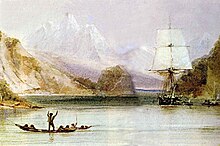
A watercolour of HMS Beagle
- 1835. William Swainson (English, 1789–1855) wrote A Treatise on the Geography and Classification of Animals (1835) in which he used ad hoc land bridges to explain animal distributions. He included some interesting, second-hand observations on Old World army ants.
- 1836. William Buckland (English, 1784–1856) wrote Geology and Mineralogy Considered with Reference to natural Theology (1836) in which he stated that there were several creations.
- 1839. Theodor Schwann (German, 1810–1882) wrote Mikroskopischen Untersuchungen über die Übereinstimmungen in der Strucktur und dem Wachstum der Thiere und Pflanzen (1839). With him the cell theory was made general.
- 1839. Louis Agassiz (Swiss-American, 1807–1873) arrived in the U.S. A former student of Cuvier, Louis Agassiz was an expert on fossil fishes. He founded the Museum of Comparative Zoology, at Harvard University, and became Darwin's North American opposition. He was a popularizer of natural history and exhorted students to "study nature, not books". His Nomenclator Zoologicus (1842–1847) was a pioneering effort.
- 1840. Jan Evangelista Purkyně, a Czech physiologist, at Wrocław proposes that the word "protoplasm" be applied to the formative material of young animal embryos.

1842 Plate from Dictionnaire universel d'histoire naturelle by
- 1842. Baron Justus von Liebig wrote Die Thierchemie in which he applied classic methodology to studying animal tissues, suggested that animal heat is produced by combustion, and founded the science of biochemistry.
- 1843. John James Audubon, age 58, ascended the Missouri River to Fort Union at the mouth of the Yellowstone to sketch wild animals.
- 1844. Robert Chambers (Scottish, 1802–1871) wrote the Vestiges of the Natural History of Creation (1844) in which he included early evolutionary considerations. The most primitive species originated by spontaneous generation, but these gave rise to more advanced ones. This book, anonymously published, had a profound effect on Wallace. Evolution "was the manner in which the Divine Author has been pleased to work".
- 1845. von Siebold recognized Protozoa as single-celled animals.
- 1848. Josiah C. Nott (American), a physician from New Orleans, published his belief that mosquitoes transmitted malaria.
- 1848. Alfred Russel Wallace (British, 1823–1913) and Henry W. Bates (English, 1825–1892) arrived in the Amazon River valley in 1848. Bates stayed until 1859, exploring the upper Amazon. Wallace remained in the Amazon until 1852, exploring the Rio Negro. Wallace wrote A Narrative of Travels on the Amazon and Rio Negro (1853), and Bates wrote The Naturalist on the River Amazons (1863). Later (1854–1862), Wallace went to the Far East, reported in his The Malay Archipelago (1869).
- 1849. Arnold Adolph Berthold demonstrated by castration and testicular transplant that the testis produces a blood-borne substance promoting male secondary sexual characteristics.
- 1850? Thomas Hardwicke (British naturalist) discovered the lesser panda (Ailurus fulgens) in northern India.
- 1855. Alfred Russel Wallace (English, 1823–1913) wrote On the law which has regulated the introduction of new species (Ann. Mag. Nat. Hist., September 1855) with evolutionary ideas that drew upon Wallace's experiences in the Amazon.
- 1857. Discovery of Neanderthal skull-cap.
- 1857–1881. Henri Milne-Edwards (French, 1800–1885) introduced the idea of physiologic division of labor and wrote a treatise on comparative anatomy and physiology (1857–1881).

- 1859. Charles Darwin publishes On the Origin of Species, explaining the mechanism of evolution by natural selection and founding the field of evolutionary biology.
- 1864. Louis Pasteur disproved the spontaneous generation of cellular life.
- 1865. Gregor Mendel demonstrated in pea plants that inheritance follows definite rules. The Principle of Segregation states that each organism has two genes per trait, which segregate when the organism makes eggs or sperm. The Principle of Independent Assortment states that each gene in a pair is distributed independently during the formation of eggs or sperm. Mendel's trailblazing foundation for the science of genetics went unnoticed, to his lasting disappointment.
- 1869. Friedrich Miescher discovered nucleic acids in the nuclei of cells.
- 1876. Oskar Hertwig and Hermann Fol independently described (in sea urchin eggs) the entry of sperm into the egg and the subsequent fusion of the egg and sperm nuclei to form a single new nucleus.
- 1892. Hans Driesch separated the individual cells of a 2-cell sea urchin embryo and shows that each cell develops into a complete individual, thus disproving the theory of preformation and showing that each cell is "totipotent," containing all the hereditary information necessary to form an individual.
20th century[]
1900–1949[]
- 1900. Three biologists Hugo de Vries, Carl Correns, Erich von Tschermak independently rediscovered Mendel's paper on heredity.
- 1905. William Bateson coined the term "genetics" to describe the study of biological inheritance.
- 1907. Ivan Pavlov demonstrated conditioned responses with salivating dogs.
- 1922. Aleksandr Oparin proposed that the Earth's early atmosphere contained methane, ammonia, hydrogen, and water vapour, and that these were the raw materials for the origin of life.
- 1935. Konrad Lorenz described the imprinting behavior of young birds.
- 1937. In Genetics and the Origin of Species, Theodosius Dobzhansky applies the chromosome theory and population genetics to natural populations in the first mature work of neo-Darwinism, also called the modern synthesis, a term coined by Julian Huxley.

Prior to the discovery of a living example in 1938, coelacanths were thought to have been extinct for 65 million years.
- 1938. A living coelacanth was found off the coast of southern Africa.
- 1940. Donald Griffin and Robert Galambos announced their discovery of echolocation by bats.
1950–1999[]
- 1952. American developmental biologists Robert Briggs and Thomas King cloned the first vertebrate by transplanting nuclei from leopard frog embryos into enucleated eggs. More differentiated cells were the less able they are to direct development in the enucleated egg.
- 1961. Joan Oró found that concentrated solutions of ammonium cyanide in water can produce the nucleotide adenine, a discovery that opened the way for theories on the origin of life.
- 1967. John Gurdon used nuclear transplantation to clone an African clawed frog; first cloning of a vertebrate using a nucleus from a fully differentiated adult cell.
- 1972. Stephen Jay Gould and Niles Eldredge proposed an idea called "punctuated equilibrium", which states that the fossil record is an accurate depiction of the pace of evolution, with long periods of "stasis" (little change) punctuated by brief periods of rapid change and species formation (within a lineage).
- 1996. Dolly the sheep was first clone of an adult mammal.
References[]
- ^ Charles A. Reed. Animal Domestication in the Prehistoric Near East: The origins and history of domestication are beginning to emerge from archeological excavations. Science, Vol. 130, no. 3389 (December 11, 1959), pp. 1629–1639
- ^ Lascaux, a visit to the cave.
- ^ Shaw, George; Nodder, Frederick Polydore (1799). "The Duck-Billed Platypus, Platypus anatinus". The Naturalist's Miscellany. 10 (CXVIII): 385–386. doi:10.5962/p.304567.
External links[]
Categories:
- Zoology timelines
- History of zoology

